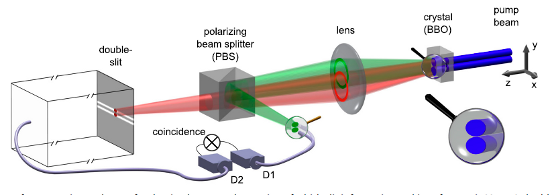In which we do a little ResearchBlogging, taking a look at a slightly confusing paper putting a new twist on the double-slit experiment. ———— I’m off to California this afternoon, spending the rest of the week at DAMOP in Pasadena (not presenting this year, just hanging out to see the coolest new stuff in Atomic,… Continue reading Single Photons Are Still Photons: “Wave-particle dualism and complementarity unraveled by a different mode”
Tag: research-blogging
What Goes Around Is Really Round: “Improved measurement of the shape of the electron”
The big physics story of the week is undoubtedly the new limit on the electric dipole moment (EDM) of the electron from Ed Hinds’s group at Imperial College in the UK. As this is something I wrote a long article on for Physics World, I’m pretty psyched to see this getting lots of media attention,… Continue reading What Goes Around Is Really Round: “Improved measurement of the shape of the electron”
Active Engagement Works: “Improved Learning in a Large-Enrollment Physics Class”
Physics is a notoriously difficult and unpopular subject, which is probably why there is a large and active Physics Education Research community within physics departments in the US. This normally generates a lot of material in the Physical Review Special Topics journal, but last week, a PER paper appeared in Science, which is unusual enough… Continue reading Active Engagement Works: “Improved Learning in a Large-Enrollment Physics Class”
Bouncing Neutrons for Fun and Science: “Realization of a gravity-resonance-spectroscopy technique”
Several people blogged about a new measurement of gravitational states of neutrons done by physicists using ultracold neutrons from the Institut Laue-Langevin in France. I had to resort to Twitter to get access to the paper (we don’t get Nature Physics here, and it’s way faster than Inter-Library Loan), but this is a nice topic… Continue reading Bouncing Neutrons for Fun and Science: “Realization of a gravity-resonance-spectroscopy technique”
Interference of Independent Photon Beams: The Pfleegor-Mandel Experiment
Earlier this week, I talked about the technical requirements for taking a picture of an interference pattern from two independent lasers, and mentioned in passing that a 1967 experiment by Pfleegor and Mandel had already shown the interference effect. Their experiment was clever enough to deserve the ResearchBlogging Q&A treatment, though, so here we go:… Continue reading Interference of Independent Photon Beams: The Pfleegor-Mandel Experiment
Indirect Excitation Control: Ultrafast Quantum Gates for Single Atomic Qubits
Last week, John Baez posted a report on a seminar by Dzimitry Matsukevich on ion trap quantum information issues. In the middle of this, he writes: Once our molecular ions are cold, how can we get them into specific desired states? Use a mode locked pulsed laser to drive stimulated Raman transitions. Huh? As far… Continue reading Indirect Excitation Control: Ultrafast Quantum Gates for Single Atomic Qubits
Measuring Gravity: Ain’t Nothin’ but a G Thing
There’s a minor scandal in fundamental physics that doesn’t get talked about much, and it has to do with the very first fundamental force discovered, gravity. The scandal is the value of Newton’s gravitational constant G, which is the least well known of the fundamental constants, with a value of 6.674 28(67) x 10-11 m3… Continue reading Measuring Gravity: Ain’t Nothin’ but a G Thing
Melting Simulated Insulators
The Joerg Heber post that provided one of the two papers for yesterday’s Hanbury Brown Twiss-travaganza also included a write-up of a new paper in Nature on Mott insulators, which was also written up in Physics World. Most of the experimental details are quite similar to a paper by Markus Greiner’s group I wrote up… Continue reading Melting Simulated Insulators
Bunches and Antibunches of Atoms: Hanbury Brown and Twiss Effects in Ultracold Atoms
Two papers in one post this time out. One of these was brought to my attention by Joerg Heber, the other I was reminded of when checking some information for last week’s mathematical post on photons. They fit extremely well together though, and both relate to the photon correlation stuff I was talking about last… Continue reading Bunches and Antibunches of Atoms: Hanbury Brown and Twiss Effects in Ultracold Atoms
High Excitement in Review: “Quantum information with Rydberg atoms”
I’m a big fan of review articles. For those not in academic science, “review article” means a long (tens of pages) paper collecting together the important results of some field of science, and presenting an overview of the whole thing. These vary somewhat in just how specific they are– some deal with both experiment and… Continue reading High Excitement in Review: “Quantum information with Rydberg atoms”
